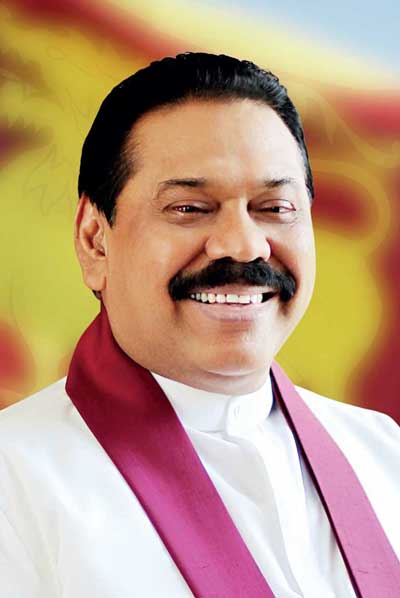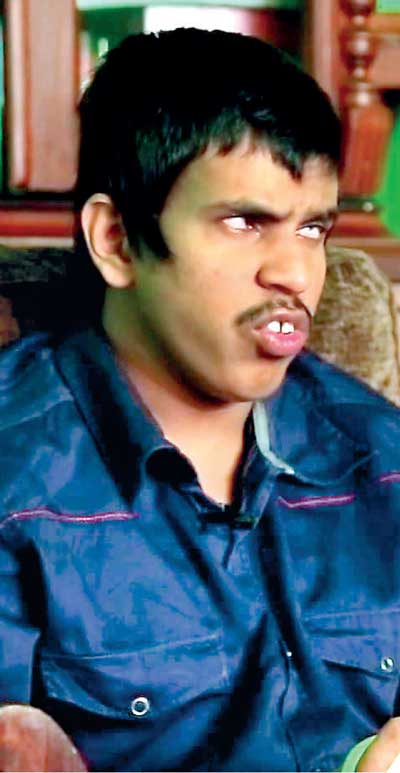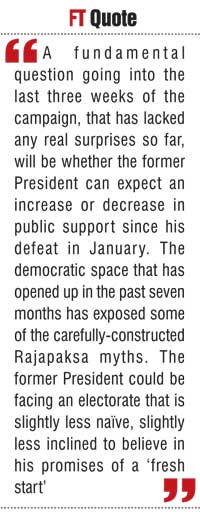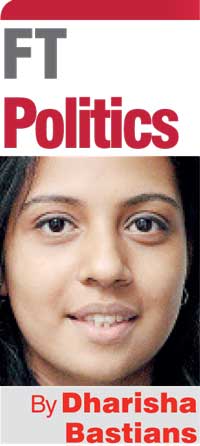Thursday Apr 24, 2025
Thursday Apr 24, 2025
Thursday, 23 July 2015 00:10 - - {{hitsCtrl.values.hits}}

Unaccustomed to running election campaigns without State power, former President Mahinda Rajapaksa finds himself in an awkward position
Sri Lanka’s blind soothsayer, Indika Thotawatte, has struck again. The boy-like astrologer rose to fame country-wide after he accurately predicted former President Mahinda Rajapaksa’s electoral defeat in January. Astrologers being a threatened species during the Rajapaksa years, every other soothsayer on a show aired on a private television channel before the January presidential poll predicted a narrow win for Rajapaksa. Thotawatte disagreed. The victory of Maithripala Sirisena on 8 January, the blind fortune-teller said, was a foregone conclusion.
In an interview with a State-owned newspaper last weekend, Thotawatte revealed that Gotabaya Rajapaksa, the country’s former Defence Secretary and arguably the most powerful official in the previous administration, had got in touch after the show.
“He asked if I could help them to win the presidential election. They didn’t want me to help them with publicity for the campaign. They asked if I knew any occult practices that would alter the course of events. But that was a certain defeat. Even the forces of nature had blessed Maithripala Sirisena’s victory,” Thotawatte told the Sinhalese weekly.
His latest prediction is that the defeated President could win a seat to enter Parliament in the 17 August poll, but his chances of winning the premiership remain slim. In fact, Thotawatte claims 17 August is a horrendously bad day, astrologically speaking, for Mahinda Rajapaksa. This is a strange twist, since eight is believed to be the former President’s lucky number. When the poll date was announced in June, it was pounced upon as being favourable to the ex-President who was battling hard to win a nomination on the UPFA ticket at the time.
Historically, the number eight has been good for Mahinda Rajapaksa’s electoral fortunes. He won the presidency for the first time in 2005 on 17 November. That may have been a happy accident. The second time, President Rajapaksa had control. The presidential election in which he would face off against former Army Chief Sarath Fonseka was set for 26 January 2010. The election held to usher in the Parliament that would help him to execute his post-war political mandate was held on 8 April 2010. The UPFA and President Rajapaksa, then at their strongest following the defeat of the LTTE, secured an easy victory, winning 144 seats in the 225-member Parliament, just 6 short of a two-thirds majority.

Indika Thotawatte
Lucky number 8
In the crucial 2015 presidential contest, the Rajapaksa camp showed similar unwillingness to deviate from the lucky formula. The date was set for 8 January, appropriately featuring President Rajapaksa’s lucky number. Ironically, the date acted like a talisman for the anti-Rajapaksa movement when realisation dawned that the historic election would be held on the sixth anniversary of The Sunday Leader Editor Lasantha Wickrematunge’s assassination.
Unlikely to make any major political moves without consulting his astrologers, the date was meant to strengthen the incumbent’s hand, and assist his victory. But in the soothsayer community, whispers abounded about the malefic effects of the chosen date.
One astrologer, who had felt the heavy hand of Rajapaksa justice a few years previously, insisted that Rajapaksa would not lose his job in the January poll in interviews with reporters in late December 2014. Privately, he provided extensive reasons why 8 January was a profoundly unlucky for the incumbent President. The particular date assured ‘swift destruction’, the astrologer said, displaying a series of charts on his fancy double-sided computer monitor to verify his claims. It was impossible for the presidential soothsayers to have missed the signs, he conceded. “This is elementary astrology, it’s almost as if it was an intentional mistake,” he chuckled conspiratorially. 
Thotawatte, a much braver man, now insists 17 August is, again, a potentially ruinous day for Rajapaksa, even though the numbers add up to 8, the ex-President’s favoured numerical. Unlike in the several key elections during his tenure, the former President had no direct influence over the date of the poll. This has no doubt disturbed the Rajapaksa camp, whose indulgence in sorcery and soothsaying practices is the stuff of legend.
From the former President’s own golden talisman that he worries ceaselessly in his palm, to the black magic against his political opponents practiced by the self-anointed ‘royal’ soothsayer, Sumanadasa Abeygunewardena, rituals and fortune-telling were an integral part of the Rajapaksa political arsenal. Two key Rajapaksa brothers were complete vegetarians, to ensure the spells they cast over themselves with ritualistic offerings to the gods would hold.
None of this is good news for the former President, a deeply superstitious man.
But for the Rajapaksa campaign now gearing for the August 2015 poll, the absence of State resources to exploit must seem the greatest malefic of all.
Unaccustomed to running election campaigns without State power, the former President finds himself in an awkward position. The memory of Rajapaksa excess still glows brightly in the public conscience, rekindled now with the former President’s re-entry into the political fray. His campaign cannot afford to be too lavish or break too many election laws. In the Kurunegala District, where Rajapaksa is leading the UPFA candidate list, the absence of posters and cut-outs of the glowering ex-President is a stark reminder that he is no longer in control.
Control of the State
Since 2005, Mahinda Rajapaksa has only clinched power in national contests while at the helm of State affairs. Even when his Party Leader, then President Chandrika Kumaratunga, was not fully backing his candidacy in the 2005 election, the Rajapaksa campaign still commanded the might of the Government machinery, State property, the organising power of its loyal local councils, Samurdhi officials and Grama Sevakas and the reach of the State-controlled media.
In 2010, Rajapaksa was at the zenith of his power, after he finished the LTTE only seven months before his re-election. By January 2015, President Rajapaksa had turned the abuse of State property during election season into a fine art. He ran a multi-billion rupee campaign. Faithful to the last, the Rajapaksa loyalist-owned agency did some of its best work. His social media campaign was streamlined and professional, the Government ushered into power on 8 January has never been able to come close, even after six months in power.
Professionally shot documentaries aired nightly on State media, portraying the Rajapaksas as triumphant Tiger slayers and the undisputed gods of Sri Lanka’s hyper-development drive. The Rajapaksa campaign was so powerful financially that it could outspend the Opposition campaign by Rs 20-30 million in a single night, sources with knowledge of opposition financing told the Daily FT during the January poll. And that was only in the privately-owned media. The Rajapaksa campaign still owes over 100 million in advertising dues to the State media for their January propaganda.
As sitting President, Rajapaksa used Sri Lanka Air Force helicopters to hop across the island, bullet-proof BMWs sped him into the meeting grounds and once he was done, Mercedes Benz recreational vehicles stood by with luxury rest-room and relaxation facilities before he was air-lifted back to Colombo.
His family members were also treated to helicopter rides to election rallies, with logs of the Air Force passenger manifests corresponding directly with campaign stops on a given date, for his son Namal Rajapaksa or brother Basil Rajapaksa. As incumbent Head of State, President Rajapaksa was entitled to the helicopter rides; his family technically had to pay. The SLAF is yet to collect some Rs. 70 million in chopper debts owed by the ex-President’s family.
Level playing field
For the first time in a long time, Mahinda Rajapaksa is playing on a slightly more level playing field.
During a stormy meeting with President Sirisena in early May, Rajapaksa laid out five demands, including his nomination as prime ministerial candidate, and crucially, the extension of the term of the local councils, set to expire on 15 May. Last elected in 2011, the local councils are filled with Rajapaksa loyalists, valuable party cadre for the ex-President’s campaign if he were to contest the Parliamentary election. 
The Sri Lanka Freedom Party relies on the organisational strength of local councilmen and Government officials at the lowest levels to muster grassroots support. For the better part of 20 years, these elected representatives to the lowest levels of Government and Samurdhi officials who maintain direct links to rural electorate have served as the party’s grassroots structure.
By virtue of long spells in opposition, and a history of strong ground campaigns run by former leaders, the UNP still banks on some vestiges of grassroots organisation that has recently been rejuvenated to some degree by the entry of party stalwart Kabir Hashim as General Secretary, replacing the largely-ineffectual Tissa Attanayake. The JVP traditionally runs the strongest grassroots campaigns, a factor that made the party a valuable ally in both the 2010 and 2015 presidential contests.
By inserting himself into the UPFA campaign as the party’s de facto campaign leader, after President Sirisena used his entry to stay neutral during the election, former President Rajapaksa must campaign for all his loyalists. He can no longer make flying visits to campaign rallies, but must use the roads, fighting traffic and racing against the clock, or pay for his helicopter rides himself.
The UPFA is running its Parliamentary polls campaign as a mirror image of its presidential poll strategy, using the same gimmicks, the same cult appeal of their now once-defeated leader, the same hackneyed election slogans. In some very tragic cases, the Rajapaksa campaign is recycling propaganda from the presidential election in January, especially on social media.
By contrast, the former President’s son Namal is running a more professional campaign for the Hambantota District, with advertisements and propaganda more reminiscent of the Rajapaksa glory days. Interestingly, Namal Rajapaksa makes no appearance at his father’s rallies and the former President features rarely in his son’s campaign adverts.
The trouble with making Mahinda Rajapaksa appear presidential again is that every voter will not be able to cast his or her vote for the ex-President as a candidate. His electorate is now confined to the Kurunegala District, far from his home base in Hambantota. The Parliamentary poll is an every-man-for-himself battle.
If Mahinda Rajapaksa is required at every campaign rally organised by his loyalists and these loyalists are expected to turn up at all his major events, how much time can they spend on their personal campaigns to reach out to their own electorates? If Mahinda Rajapaksa is the star of every election rally, how do the voters find out about the MPs contesting ‘with Mahinda’ in their districts? And the jury is still out on whether Mahinda Rajapaksa’s larger-than-life presence in the UPFA campaign will help or hinder individual campaigns of SLFP members who tried to stay largely neutral during the nominations tussle.
Same old rhetoric
That the ex-President’s campaign knows that the Rajapaksa brand has been badly wounded is clear from the tone and expression at their first campaign rallies since the nominations period ended. ‘Second chances’ appear to be a recurrent theme, even after Mahinda Rajapaksa spent nearly 10 years in the country’s highest chair.
He pledges to root out corruption, highlighting the UNP’s disastrous Central Bank bond scam, yet he campaigns unabashedly on the stages of those candidates facing serious corruption charges, many of them just released on bail. He makes new promises about reconciliation, but the UPFA list in Kurunegala fails to feature a single Muslim candidate in a district where the community is a small but significant minority. The threats to national security, the dangers to the motherland placed in the hands of traitors and foreign conspirators, the former President’s stump speeches are peppered with the same rhetoric.
The UNP, leading the opposition to Rajapaksa, makes equally unimaginative stump speeches, but they campaign holding the spectre of Rajapaksa resurgence before the voters, drawing the change-makers of 8 January, slightly disillusioned and more wary, back into their fold.
The JVP is also likely to make some headway in the 17 August election, exploiting voter disillusionment and drawing votes from both main parties to increase their percentages in key districts. More JVP votes are likely to be drawn from the SLFP/UPFA in this election, with the blues fractious and divided, much like the UNP in 2010.
In the 2010 presidential poll, in the Kurunegala District, Rajapaksa polled 63% against Fonseka’s 35.4%. Results of the Parliamentary election in 2010 showed that the JVP had drawn votes away from a battered UNP three months later, in the same district. In the April 2010 general election, the UPFA’s percentage remained largely unchanged at 63.8%, but the UNP dipped from 35% to 31.7% in that election. The JVP mustered nearly 4% of the vote in the district, clearly eating into the UNP percentages three months later.
By 2015, the UNP fielding Maithripala Sirisena as common candidate, narrowed the gaps significantly in the Kurunegala District, polling 45.7% against Rajapaksa’s 53.6%. The figures are closer to Mahinda Rajapaksa’s margins against Ranil Wickremesinghe in the Kurunegala District in 2005 and are likely to be reflected in the 17 August election, making for a close contest between the two main parties and a significant upsurge in support for the JVP, some analysts predict.
A fundamental question going into the last three weeks of the campaign, that has lacked any real surprises so far, will be whether the former President can expect an increase or decrease in public support since his defeat in January. The democratic space that has opened up in the past seven months has exposed some of the carefully-constructed Rajapaksa myths. The former President could be facing an electorate that is slightly less naïve, slightly less inclined to believe in his promises of a ‘fresh start’.
The Akuressa debacle
The incident at Rajapaksa’s Akuressa rally on Tuesday, captured on video and now viewed over 120,000 times on a single website, may be the first sign of strain at the pressure of this election upon a man now nearly 70 years of age. Viewed in slow motion, the images appear to show an enraged Rajapaksa raising his fists against someone in the crowd, before he is led away by his security personnel, nursing the fingers of his right hand.
Eyewitnesses say the crowd got unruly as the former President got out of his car and made his way to the main stage, with some of them grabbing his hands and trying to pull him into the melee. Since his security took some time to get to him, the ex-President took matters into his own hands. President Rajapaksa’s spokesman said the former President was only trying to protect himself, since he had not been granted adequate security by the Government.
Explanations have surfaced on social media over the day, claiming that the ex-President had thought he was under attack from a suicide bomber, and was trying to defend himself. Known for his bad temper in private, President Rajapaksa has rarely let his emotions get the better of him in public. His public face is almost always genial. The outburst at Akuressa was an aberration. Moments later he was greeting supporters and politicians on stage with a confident smile. But in terms of public perceptions, the slip could prove costly.
Ten days into a crucial election campaign, the scene is set for a rematch, between the two forces of the 8 January battle. Defeated in that election, Mahinda Rajapaksa is trying to repackage himself as a credible alternative to the UNP-led Government his campaign says has dragged the country to the brink of economic and social ruin. It was a dangerous gamble, and the former President must be given credit for leaping back into the fray with such abandon, even if his motivations could be questionable.
Politics might be all about second chances and the potential to reform, but eight months may have been too soon to try the launch of Rajapaksa 2.0.
Discover Kapruka, the leading online shopping platform in Sri Lanka, where you can conveniently send Gifts and Flowers to your loved ones for any event including Valentine ’s Day. Explore a wide range of popular Shopping Categories on Kapruka, including Toys, Groceries, Electronics, Birthday Cakes, Fruits, Chocolates, Flower Bouquets, Clothing, Watches, Lingerie, Gift Sets and Jewellery. Also if you’re interested in selling with Kapruka, Partner Central by Kapruka is the best solution to start with. Moreover, through Kapruka Global Shop, you can also enjoy the convenience of purchasing products from renowned platforms like Amazon and eBay and have them delivered to Sri Lanka.
Discover Kapruka, the leading online shopping platform in Sri Lanka, where you can conveniently send Gifts and Flowers to your loved ones for any event including Valentine ’s Day. Explore a wide range of popular Shopping Categories on Kapruka, including Toys, Groceries, Electronics, Birthday Cakes, Fruits, Chocolates, Flower Bouquets, Clothing, Watches, Lingerie, Gift Sets and Jewellery. Also if you’re interested in selling with Kapruka, Partner Central by Kapruka is the best solution to start with. Moreover, through Kapruka Global Shop, you can also enjoy the convenience of purchasing products from renowned platforms like Amazon and eBay and have them delivered to Sri Lanka.